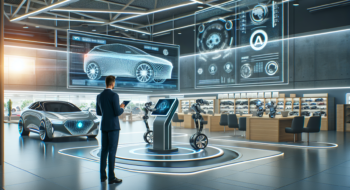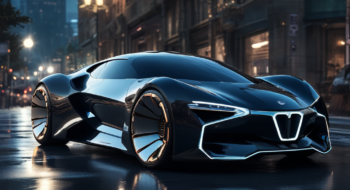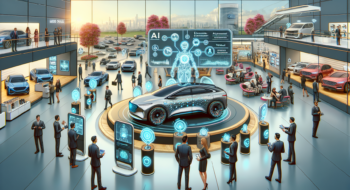The automotive industry is undergoing a profound transformation, driven by advancements in artificial intelligence (AI). As vehicles become increasingly connected and autonomous, AI technologies are playing a pivotal role in enhancing safety, efficiency, and user experience. From intelligent navigation systems to predictive maintenance and personalized in-car experiences, AI is reshaping how we think about transportation. In this exploration, we will delve into the various applications of AI in the automotive sector and examine how they are revolutionizing the way we drive and interact with our vehicles.
1. Autonomous Vehicles: The Future on Wheels
Autonomous vehicles are the crown jewels in the automotive AI revolution. Companies like Waymo and Tesla are leading the charge, harnessing AI to enable cars to drive themselves. Machine learning algorithms analyze real-time data from cameras, sensors, and radar systems, allowing these vehicles to make decisions akin to a human driver. Imagine reading a book or finishing a presentation during your commute—such luxury is just a few car models away!
2. Predictive Maintenance: Keeping Vehicles in Tip-Top Shape
Gone are the days when drivers had to guess when their car needed maintenance. With AI’s predictive maintenance capabilities, vehicles can monitor themselves and predict potential failures before they happen. Technologies like IBM Watson IoT are analyzing data from various sensors within cars—tire pressure, engine temperature, you name it—to suggest timely services. This not only enhances convenience but also extends the life of vehicles significantly.
3. Smart Manufacturing: Streamlining Production
AI is not just about the end product; it’s also revolutionizing how vehicles are manufactured. Companies like Ford and General Motors have begun using AI-driven robots in their assembly lines. These robots can adapt to changing production needs in real-time, increasing efficiency and minimizing waste. The result? Quicker production cycles and the ability to produce highly customized vehicles, tailored to individual consumer desires.
4. Enhanced Safety Features: The AI Guardian
Imagine a car that can predict an impending collision or apply the brakes before you even react. AI-enhanced safety features are becoming standard in modern vehicles. For instance, systems like Tesla’s Autopilot and Volvo’s City Safety utilize AI to interpret sensory data, automatically engaging brakes or steering to avoid potential accidents. The prospect of significantly reducing road fatalities thanks to AI is no longer just a dream.
5. Intelligent Navigation Systems: Your Personal Chauffeur
AI is dramatically improving navigation systems, making trips not only easier but also safer. Google Maps and Waze utilize artificial intelligence to assess real-time traffic conditions, offering the most efficient routes for drivers. Some cars even feature AI that learns your habits, suggesting routes you’re likely to prefer based on your driving history. It’s like having a personal assistant on your dashboard!
6. Voice Recognition: Conversational Driving
Forget about fiddling with buttons while driving. Thanks to AI, voice recognition technology is paving the way for safer in-car communication. Systems like Apple CarPlay and Android Auto enable drivers to control navigation, music, and even calls with simple vocal commands. The result? A truly hands-free experience, reducing distractions and fostering road safety.
7. AI in Vehicle Design: Tailoring the Ride
Ever wondered how manufacturers design vehicles that delight drivers? AI plays a huge role in this process. Using sophisticated algorithms, designers can analyze consumer preferences, market trends, and even predictive analytics to create models that resonate with buyers. With the help of AI, the notion of ‘one-size-fits-all’ in automobile design is quickly becoming obsolete.
8. Customer Experience Enhancement: The Personalized Touch
AI is enabling automotive companies to personalize the customer experience in ways previously unimaginable. By analyzing data from various sources, including user behavior and preferences, companies can tailor marketing messages and product offerings specifically to individual consumers. This not only increases satisfaction but also fosters brand loyalty.
9. Connected Vehicles: The Internet of Things on Wheels
With connected vehicles, AI is integrating cars into the larger IoT ecosystem. This allows vehicles to communicate with one another and with infrastructure, like traffic signals or road signs. An example? If you’re in a traffic jam due to an accident, your vehicle could be alerted by nearby cars, allowing for a reroute before you get stuck. The future is indeed bright for connected vehicles!
10. Fleet Management Solutions: Efficiency Redefined
For businesses relying heavily on transportation, AI has introduced game-changing fleet management solutions. Using AI-driven platforms, companies can monitor vehicle conditions, routes, fuel usage, and even driver behavior. This results in significant cost savings and optimized operations, making fleets more sustainable and efficient.
11. Insurance Underwriting: Smarter Risk Assessment
Insurers are tapping into AI to revolutionize risk assessment and claims processing. By utilizing telematics data, AI can provide more accurate premiums based on real-time driving behavior rather than static demographics. This means safer drivers may pay less, while riskier behaviors could lead to higher rates. A more tailored insurance experience is on the horizon!
12. Augmented Reality Dashboards: Information at a Glance
In a tech-savvy world, the dashboard is becoming a digital playground. Imagine a windshield that projects critical information like speed, navigation directions, and safety alerts directly onto the glass—this is augmented reality in action! Companies like BMW are incorporating AR technology into their vehicles, leading us into a new era of driving information that enhances safety and enjoyment.
13. Energy Optimization: Driving Towards Sustainability
AI is also helping the automotive sector embrace sustainability by optimizing energy consumption. Electric vehicles equipped with AI can analyze driving patterns to maximize battery life. They can also intelligently manage energy use based on traffic conditions. By adopting these technologies, manufacturers can contribute to reducing the carbon footprint of transportation significantly.
14. Human-Machine Interface: Making Connections
The human-machine interface (HMI) is evolving with AI to ensure seamless interaction between the driver and their vehicle. Innovative systems are being designed to adapt to how drivers interact with their cars, whether through touch, voice, or gestures. This dynamism not only makes driving more enjoyable but also enhances safety by ensuring the driver maintains focus on the road.
15. Data-Driven Decision Making: The Backbone of Innovation
With every vehicle becoming a data-generating machine, automakers can now harness this information to drive innovation. Companies are leveraging big data analytics powered by AI to understand consumer behavior, anticipate market trends, and make informed decisions. This data-driven approach is essential for staying competitive in today’s fast-paced automotive landscape.
16. Supply Chain Management: Streamlining Operations
AI is helping streamline supply chain management by predicting shortages, tracking inventory levels, and automating ordering processes. With AI capabilities, companies like Toyota and Volkswagen can respond to market demands efficiently, ensuring that production lines run smoothly without interruptions. Less downtime equals greater profitability!
17. 3D Printing in Automotive Design: Creating Smarter Components
Another exciting application of AI in the automotive industry is in 3D printing. AI algorithms optimize designs for manufacturability, allowing companies to create complex parts with maximum efficiency. This not only saves time but also reduces production costs significantly. As 3D printing technologies advance, we can expect to see more detailed, customized parts being integrated into vehicles.
18. Behavioral Analytics: Understanding Consumers Better
AI not only enhances vehicles but also offers insights into consumer behavior. By analyzing data related to how consumers interact with their vehicles, manufacturers can develop products that better meet their desires. Whether it’s adaptive cruise control or seat comfort, AI allows automakers to tap into what truly matters to consumers.
19. Collaboration with Tech Giants: A Strong Partnership
The automotive industry is not going it alone. Collaborations with tech giants like Google and Amazon have accelerated AI development within vehicles. From cloud computing services to analytics platforms, these partnerships enable automotive manufacturers to integrate the latest tech innovations rapidly, enhancing vehicles’ capabilities and features.
20. The Road Ahead: AI’s Endless Possibilities
The integration of AI into the automotive industry is just beginning. As technology continues to evolve, we’ll likely see even more groundbreaking applications that we can only begin to imagine. From enhancing vehicle performance to transforming how vehicles are owned and operated, AI promises to make our travel experiences smarter and more enjoyable. Buckle up, because the ride forward is going to be thrilling!
In conclusion, the automotive industry stands at the brink of a revolutionary change, driven by AI. This remarkable technology is not just changing our vehicles but reshaping our very comprehension of transportation. The future of automotive innovation is bright, and we can all look forward to exciting advancements that promise to enhance safety, convenience, and sustainability. And remember, as these innovations roll out, they’re not just about making cars smarter but transforming our driving experiences altogether!
To learn more about how artificial intelligence is continuing to shape various industries, visit Neyrotex.com.







